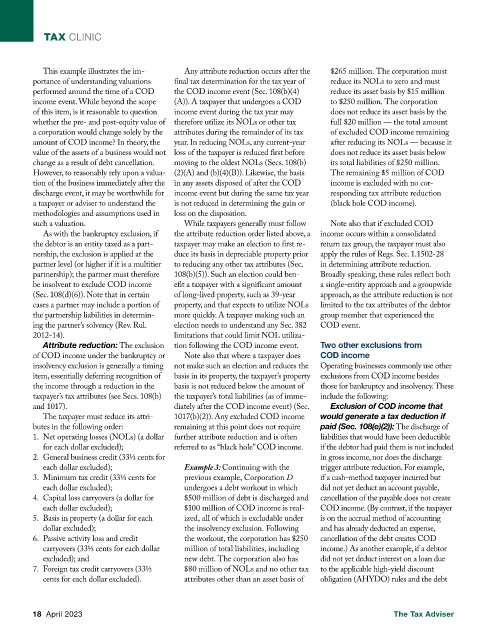Page 198 - TaxAdviser_Jan_Apr23_Neat
P. 198
TAX CLINIC
This example illustrates the im- Any attribute reduction occurs after the $265 million. The corporation must
portance of understanding valuations final tax determination for the tax year of reduce its NOLs to zero and must
performed around the time of a COD the COD income event (Sec. 108(b)(4) reduce its asset basis by $15 million
income event. While beyond the scope (A)). A taxpayer that undergoes a COD to $250 million. The corporation
of this item, is it reasonable to question income event during the tax year may does not reduce its asset basis by the
whether the pre- and post-equity value of therefore utilize its NOLs or other tax full $20 million — the total amount
a corporation would change solely by the attributes during the remainder of its tax of excluded COD income remaining
amount of COD income? In theory, the year. In reducing NOLs, any current-year after reducing its NOLs — because it
value of the assets of a business would not loss of the taxpayer is reduced first before does not reduce its asset basis below
change as a result of debt cancellation. moving to the oldest NOLs (Secs. 108(b) its total liabilities of $250 million.
However, to reasonably rely upon a valua- (2)(A) and (b)(4)(B)). Likewise, the basis The remaining $5 million of COD
tion of the business immediately after the in any assets disposed of after the COD income is excluded with no cor-
discharge event, it may be worthwhile for income event but during the same tax year responding tax attribute reduction
a taxpayer or adviser to understand the is not reduced in determining the gain or (black hole COD income).
methodologies and assumptions used in loss on the disposition.
such a valuation. While taxpayers generally must follow Note also that if excluded COD
As with the bankruptcy exclusion, if the attribute reduction order listed above, a income occurs within a consolidated
the debtor is an entity taxed as a part- taxpayer may make an election to first re- return tax group, the taxpayer must also
nership, the exclusion is applied at the duce its basis in depreciable property prior apply the rules of Regs. Sec. 1.1502-28
partner level (or higher if it is a multitier to reducing any other tax attributes (Sec. in determining attribute reduction.
partnership); the partner must therefore 108(b)(5)). Such an election could ben- Broadly speaking, these rules reflect both
be insolvent to exclude COD income efit a taxpayer with a significant amount a single-entity approach and a groupwide
(Sec. 108(d)(6)). Note that in certain of long-lived property, such as 39-year approach, as the attribute reduction is not
cases a partner may include a portion of property, and that expects to utilize NOLs limited to the tax attributes of the debtor
the partnership liabilities in determin- more quickly. A taxpayer making such an group member that experienced the
ing the partner’s solvency (Rev. Rul. election needs to understand any Sec. 382 COD event.
2012-14). limitations that could limit NOL utiliza-
Attribute reduction: The exclusion tion following the COD income event. Two other exclusions from
of COD income under the bankruptcy or Note also that where a taxpayer does COD income
insolvency exclusion is generally a timing not make such an election and reduces the Operating businesses commonly use other
item, essentially deferring recognition of basis in its property, the taxpayer’s property exclusions from COD income besides
the income through a reduction in the basis is not reduced below the amount of those for bankruptcy and insolvency. These
taxpayer’s tax attributes (see Secs. 108(b) the taxpayer’s total liabilities (as of imme- include the following:
and 1017). diately after the COD income event) (Sec. Exclusion of COD income that
The taxpayer must reduce its attri- 1017(b)(2)). Any excluded COD income would generate a tax deduction if
butes in the following order: remaining at this point does not require paid (Sec. 108(e)(2)): The discharge of
1. Net operating losses (NOLs) (a dollar further attribute reduction and is often liabilities that would have been deductible
for each dollar excluded); referred to as “black hole” COD income. if the debtor had paid them is not included
2. General business credit (331/3 cents for in gross income, nor does the discharge
each dollar excluded); Example 3: Continuing with the trigger attribute reduction. For example,
3. Minimum tax credit (331/3 cents for previous example, Corporation D if a cash-method taxpayer incurred but
each dollar excluded); undergoes a debt workout in which did not yet deduct an account payable,
4. Capital loss carryovers (a dollar for $500 million of debt is discharged and cancellation of the payable does not create
each dollar excluded); $100 million of COD income is real- COD income. (By contrast, if the taxpayer
5. Basis in property (a dollar for each ized, all of which is excludable under is on the accrual method of accounting
dollar excluded); the insolvency exclusion. Following and has already deducted an expense,
6. Passive activity loss and credit the workout, the corporation has $250 cancellation of the debt creates COD
carryovers (331/3 cents for each dollar million of total liabilities, including income.) As another example, if a debtor
excluded); and new debt. The corporation also has did not yet deduct interest on a loan due
7. Foreign tax credit carryovers (331/3 $80 million of NOLs and no other tax to the applicable high-yield discount
cents for each dollar excluded). attributes other than an asset basis of obligation (AHYDO) rules and the debt
18 April 2023 The Tax Adviser

